1998
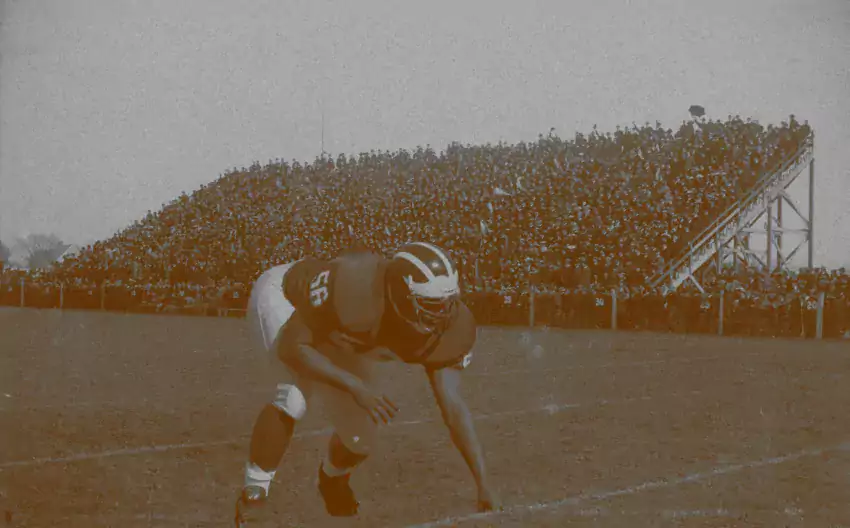
What is this? A tournament of great Michigan teams past as some gimmick to write about Old Blue over the offseason. I write up a fictitious game between two historical Michigan teams, then eulogize the loser. See the play-in round for further explanation.
Since Tom Brady’s career is now just adding some fourth quarter padding to his lead on Montana, I figured we should go back to the beginning of it. It also gives me an opportunity at the start of this series to decide what I’m going to do when a team from the Stone Age faces one from modern times who just thinks it's from the Stone Age. In truth I think it would be a slaughter, like varsity versus the club team. For the sake of keeping things interesting I’m going to set some ground rules:
- To deal with changing rules, the 1st half is played under the lower seed year's rules, and the 2nd half under the higher seed's rules.
- Old time teams will be treated like they're on a sliding scale of modern subdivisions, so for example the 1901 team will be treated as if it just romped through Division III. In general, pre-1880s=Club, pre-1916=D3, pre-War=D2, pre-1980=FCS, and late 20th century=mid-majors. This is probably inaccurate, but I don't want to punish old teams too much for existing before the University of Michigan invents time travel.
- Injured/suspended players can participate equivalent to the % of the season they played, for example the 1998 team gets Marcus Ray for about a quarter.
- I can cheat for narrative purposes
Here's the bracket, which was made by a phantom NCAA committee we can all agree doesn't know anything about these teams (because I haven't written about them yet):
---------------------------
Round of 64: 1902 (7-seed) vs 1998 (10-seed)
Willie Heston outpaces 1998 safety DeWayne Patmon, because unfair characterizations of DeWayne Patmon's speed are pretty much all anyone remembers about DeWayne Patmon
Both of these teams had to follow national championship seasons, and combined most of those loaded rosters with unprecedentedly good recruiting classes. The 1902s had a much tougher act to follow, as their immediate predecessor (Yost’s first) outscored opponents 555-0. They also returned more, including Willie Heston, one of the best backs in the game’s history. Understandably, the 1998s would feel confident about beating 34 doughty white guys.
At first glance it didn't look very competitive. The 1998s had five offensive linemen over 300 pounds, including sophomores Jeff Backus and Steve Hutchinson, while the 1902s were proud of the fact that their average weight was just 180. Hayden Epstein booted the opening kickoff through the uprights, and a gaping Yost had to be informed that under 1998 rules no points were awarded for that.
The 1998 team built up a solid-enough-looking 9-0 lead in the first half, keyed by two 3rd and long conversions by Tom Brady to Markus Knight and Tai Streets. But the 1902s had the C-Will/A-Train running game scouted well, as the small but fearless Yostmen frustrated 1998 Michigan’s blockers with a seven-man front and diving into gaps. Carr extended the frustration to the fans by refusing to throw the ball despite having Tom friggin’ Brady against eleven dudes who’d literally never seen a forward pass.
The 1998s also kept having to start deep in their own zone. The 1902s managed to pin their afterbears back with a pair of gorgeous 60-yard punts by Everett Sweeney. They also were able to churn out a few first downs each drive, with Jim Herrman's '98 defense persistently confounded by Yost's no-huddle, high-tempo offense. The hurry-up forced Carr to burn all his timeouts early, and that contributed to his decision to run then take a knee when the '98s got the ball back on their 30 with over a minute remaining.
“They’re completely immune to deception,” said Lloyd Carr as his team went into the locker room for halftime. “Even our go-to screen pass wasn’t working.”
“That’s because I invented it,” quipped Yost.
[After the JUMP: The second half under 1902 rules, and one of these teams is eulogized]
THE WORST. I can’t even bring myself to talk about it. As of this writing it had 43 upvotes: Read it.
THE SALUTES MARCH ON. Catching you up on the Catching Up With series, ReadYourGuard is still talking to his old teammates. Lately he’s profiled Brent White, Clay Miller, Tim Williams, Mike Dames, David Key and Mike Reinhold.
A taste of what you’re missing, from Reinhold (goofy looking fellow at right-above):
When the film played this particular punt play and the guy came through the line unblocked, Bo came unglued. He stopped the film, flipped on the lights, and barked out, “Who is this man?” as he smacks the screen with his pointer. Mike was sitting in the back of the room with the rest of the freshman and the assistant coaches standing behind them, against the back wall. He raised his hand.
“Stand up, son.”
“What the hell were you thinking?”
This is the absolute last place on earth you want to be; standing in front of the entire team with Bo asking you a question that has no right answer. The naïve 2nd year player responded with “I don’t know”.
Oooof. Wrong answer.
WHO GETS TO PLAY THE MOST B1G WEST OF THE BIG WEST, BASICALLY. MaizeJacket went through the cross-divisional threes for each Big Ten team this year and ranked them. As expected, the B1G East teams mostly had easier cross-division games due to playing those games against the B1G West. Not sure however that I agree with his rankings: Indiana has Nebraska, Northwestern and Purdue, whereas Maryland swaps the Wildcats for the Gophers. Minnesota’s tougher than Northwestern will be I bet.
MAC’S LONG GOODBYE
In an offseason when we’re super excited about bringing in one of the best defensive coordinators in the country, some awful news about one of the greatest DCs in Michigan history was finally made public. Bill McCartney has Alzheimer’s. Mac (along with his brother) was a legendary high school coach in the Detroit area who joined the Michigan staff in 1974 after Bo made him an offer he couldn’t refuse.
When Gary Moeller took the Illinois job, Mac took over the defense, beginning a run for “McCartney’s Monsters” that set most of the defensive records in modern program history (including the three-shutout streak the 2015 team tied). We have an article this year by Dr. Sap on the 1980 team and how Coach Mac invented the Dime (4-1-6) defense to stop Purdue’s early shotgun spread-to-pass outfit. Mac went on to win a national championship as head coach of Colorado. FYI everything he remembered for the article checked out.
MEET THE NEW NUMBERS:
Rasmus broke down the history of the numbers and what inspired them, and also suggested we call that a “Winged 4”. Co-sign.
PROJECTING WIN TOTALS. Ecky Ptang (Ni!) took the S&P+ and FPI preseason numbers and made them into those likelihood charts that are so useful later on in the season for comparisons. Michigan’s centered on…10!
Ecky did a good job breaking down what things mean.
A GOOD BET. Last time I did one of these posts I shared The Saturday Edge’s annual free betting prospectus. Tim contacted me after and asked if he could sponsor another DD in return for me finding more flaws in his Big Ten preview. Here’s some nits:
- Iowa’s Matt VandeBerg’s yards per target make him more impressive than his YPC. (Okay I know I’m supposed to be ripping on things but Tim uses the Hawkeyes’ too-lucky turnover ratio last year as a negative and I wanted to point out this is why the gamblers are smarter than the hot takers).
- He’s a bit too high on Nebraska’s offense (which I think has reached its ceiling) and Northwestern’s DTs.
- Who is this “Purdue”?
- Argh name an Ohio State secondary (this could go for Urban Meyer too)
- Too high on MSU’s OL and MSU in general.
Now that I’ve read all the others I kinda think I sold it short because of the missing Michigan details.
/collects check.
A SILVER AGE OF BIG TEN COACHING. Reader canzior surveyed the Big Ten coaching field in the wake of some apparently good hires the last few years and declared the coaching talent in the league to finally be catching up to the SEC.
I did my HTTV article a few years back on the dramatic difference between how most SEC schools were hiring coaches and Big Ten coaches were. The upshot:
All told the hires I filed as “Strong” at the time went 758-377 (67% winning percentage), the “Average” ones went 404-275 (60%), and the “Cheap” hires went 320-443 (42%). Strong hires totaled a 4% improvement from those programs’ historic average winning percentage; average ones met the school average, and cheap hires have been winning at a rate 11 points below what’s typical for their programs.
Coaching hires are crootin x 100 and give similar returns: the 5-stars require massive investment but work out >50% of the time, 4-stars hit less, and 3-stars are easier to get but are a quarter as likely to be great (at which point you're paying them like a 5-star anyway).
You should hit the link for two reasons: 1.) a comprehensive chart of current Power 5 coaches and their coordinators, and 2.) the thread is a fun discussion comparing coaching years.
For that I submitted 1998: Hayden Fry, Nick Saban, Barry Alvarez, Lloyd Carr, and Joe Paterno are hall of famers; Mason, Turner, Tiller, and Barnett were some of the best coaches in their school's history; and John Cooper won just about every game except The Game. The last guy is Cam Cameron, a Bo assistant who coached the Antwaan Randle-El era, currently coordinates the Leonard Fournette offense, and was an NFL OC and HC in between. The next year Fry and Barnett were replaced with Ferentz and Randy Walker, and the Big Ten had its best year ever. Good coaching: kinda important.
ETC. What happened to Jehu? MGoColloquialisms. Wallpaper will terminate you. Only Cazzie’s number is actually retired. Children exist so that the embarrassing things adults do can look cute (I taught my 2-year-old to do the GO!-> <-BLUE! cheer). Video of players speaking at Jordan launch. Game blouses: TRUE STORY! Brian, Rittenberg, Todd Howard and I will be in Chicago in 2 weeks from yesterday. For Draftageddon complainers: MGoBlog’s offseason content 10 years ago.
YOUR MOMENT OF ZEN:
Ace forgot to put Aubrey Solomon murderating a guy in the roundup so I get to do it:
U of M commit @AubreySolomon91 in first day of pads. I am so excited to not have to go against him everyday. AUG 18 pic.twitter.com/xMcE3vHkg4
— Kevin Pych (@pychke) August 3, 2016
Thanks Ace!
Ah, I see you entrusted the future of your defensive backfield to Chris Richards
and Johnny Sears, and offered Carson Butler. You shouldn't have done that.
With the additions of two defensive tackles—the only sore spot really left in the class—the 2013 haul is starting to take shape, and this shape is looking pretty darn shapely. Granted we thought the same last year when thousands of 4-star linebackers and linemen burst out of their Ohio prisons to join the Wolverines, leaving—we thought—the staff several months to chase down a few 5-stars. Those didn't really materialize, and might not again. But it's just November … August … Early JUNE (!) and there's 20 guys in the next class, and they're mostly blue chips, and unless ESPN has done something drastic to their scores I think an entire legion of superheroes just pledged to my alma mater.
If there's any doubt that Brady and Hokesters (this is a terrible name for our coaching staff) are killin' it on the recruiting trail, consider this is now the second year in a row that a board thread has been started to ask is this the Best Michigan Football Recruiting Class Ever?
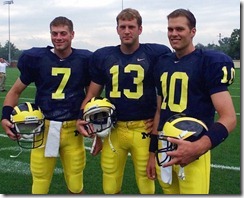 M-Wolverine beat me to it, but the gold standard here is still 1995—in a word: CharlesWoodsonTomBradyeeeeeeeeee. Also Renes, the Williamses, James Hall, Tai Streets, Aaron Shea… That class was the core of the national championship squad and populated NFL rosters for the next decade. (SI Vault--->)
M-Wolverine beat me to it, but the gold standard here is still 1995—in a word: CharlesWoodsonTomBradyeeeeeeeeee. Also Renes, the Williamses, James Hall, Tai Streets, Aaron Shea… That class was the core of the national championship squad and populated NFL rosters for the next decade. (SI Vault--->)
Putting Captain Hindsight on the sidelines for a moment, the anecdotal standard is 1998. That class was sterling at the top, headlined by Drew Henson (who had nine confirmed miracles by October of his senior year). Before pos-bang threads existed, the fanbase-wide giggle session from Henson playing catch with David Terrell in Central Park nearly toppled the young Internet. Marquise Walker (9th best player in the country overall according to Sporting News), Justin Fargas, Cato June, and Hayden Epstein were too considered Parade All Americans. LB/DL Dave Armstrong and LB Victor Hobson were close. Tom Lemming of Prep Football Report and Bobby Burton of the National Recruiting Advisor named Michigan 1st in the land; Allen Wallace of Superprep put us behind UCLA because they had DeShuan Foster.
(Also in 1998, 548-year-old Brooks MacCleod Bollinger beheaded the Kurgan, won the Prize, and signed as a freshman with Wisconsin.)
The 2013 class isn't expected to be so rich at the top, and thus is unlikely to win the same beauty contest, but it's deeper, still naming high-three star types at the point of the list where '98 was tapering off into French Canadians. The ratings are bound to shift—down as do most early commits as more of their classmates are evaluated and placed on the board, and various uncommitted Top 25 recruits leap toward this year's shiniest object—but at this point there's already enough of it to start, you know, thinking about what all that promise actually promises.
Since '98 and other successful classes occurred before humanity shifted its considerable intellect from inventing things and pondering the meaning of our existence so we could figure out how teenagers work, there is no easily accessible written record from that era with which to compare, except the little from DeSimone. Certainly 5-stars and whatnots existed before 2002, but that's where the Rivals and Scout databases begin, so we shall too.
2002 to 2013 to Various Scouting Systems
Again, I'm throwing out hindsight for now because the Class of 2013s are currently 75 percent of their way through high school, an accurate assessment of their actual abilities not available until 2017 or '18. The class before them hasn't stepped on campus yet. Half of the class before that are redshirt freshmen right now. As to the rest, yes, individual players often vastly under- or out-performed their rankings. Insert usual essay about recruiting in the aggregate is legit yo.
You've seen the way I like to represent this before, putting the classes beside each other with heat-colored levels. I'm not sure if I explained why they're lined up that way; the idea is you can see how many blue chips (4-star and higher) on the left side of the mid-line, and assess how many depth guys and fliers (3-star and lower) you're filling in with. The yellow-green guys (5.7 to Rivals, 79 to ESPN) seem to be 40-60 to become solid Big Ten-level starters or better; the ones over the 4-star threshold something more like 55-45, thus I'm trying to represent a kind of mid-point.
Clicking embiggens, but you can see what's causing the excitement already: Scout is very bullish on the recruits Michigan has verbals from already, and ESPN has either dramatically changed their ranking system or somebody slipped them a press release about Shane Morris taking practice shots at Jake Butt. The numbers are on a Googledoc if you can see if/where I went wrong with this.
At this point we allow Captain Hindsight back into the room…
The captain says 2008 is going to be rough.
This is that column on the spreadsheet where I tried to reassign star ratings based on each player's performance. A 5-star is a major-impact player who probably got drafted in the 3rd round or better; a 4-star is an All Big Ten sort—the RVBs of the world, or a player like Kovacs who's a star but has an exploitable hole in his game (yes, Kovacs was added to 2008). A 3-star is a contributor but in a just a guy way, a 2-star someone we didn't want in there (think Savoy or Banks). The "NR"s are mostly injuries or early early attrition but not the later stuff; if we got a good look at what a guy can do I rated him, e.g. Mallett is still in there for 2007, since coaching change losses aren't likely to apply to us any time soon. This isn't supposed to correlate with performance; it's meant to see what recruiting classes yield.
What struck me most is how long we seem to have been going without those 4-star-like dudes, exactly the type of guys these last two classes have been filled with, and which characterized '95. I too hope some of the more epic blue chips we're after sign up, but even if they don't, the 20 guys in this class are already among the better ones signed in the last decade, and it's not out of the question that they may some day be the best.

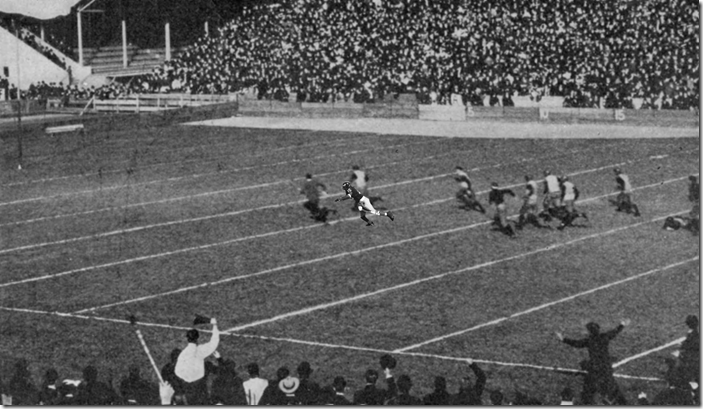
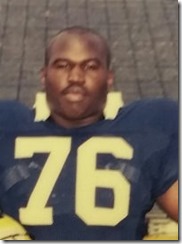
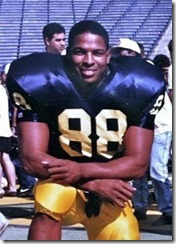
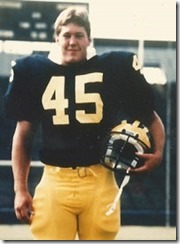
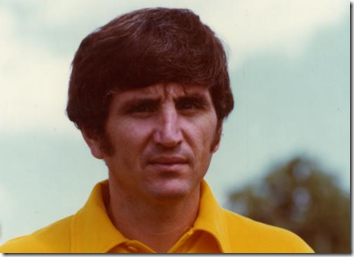



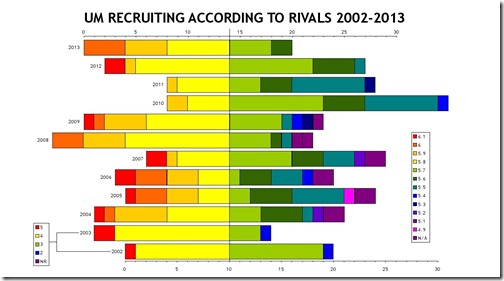
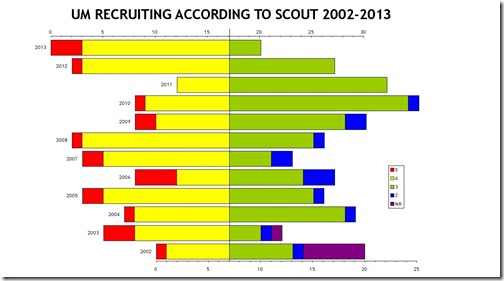
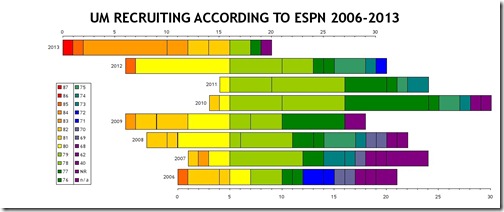

18